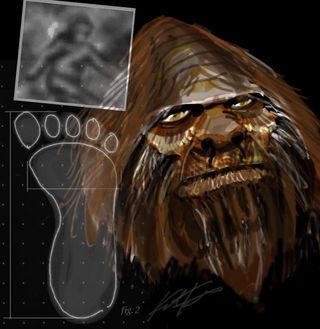
Bigfoot Hoaxer Killed in Accident

A Montana man was struck and killed by cars Sunday night while trying to hoax a Bigfoot sighting. The Montana Highway Patrol reported that Randy Lee Tenley of Kalispell was pronounced dead at the scene on U.S. Highway 93 south of Kalispell after being hit by two cars consecutively.
Tenley was wearing a military-style ghillie suit, which is a type of camouflage that resembles vegetation or foliage. Police interviewed Tenley's friends to determine why he would be wearing a full-length dark ghillie suit in the right-hand lane of the highway at night, and were apparently told of Tenley's nocturnal Bigfoot-inspired mischief.
Trooper Jim Schneider, interviewed by the Daily Inter Lake.com, said that Tenley "was trying to make people think he was Sasquatch so people would call in a Sasquatch sighting. You can't make it up. I haven't seen or heard anything like this before. Obviously, his suit made it difficult for people to see him."
The most famous film of a Bigfoot — one shot in 1967 in Bluff Creek, Calif., by a man named Roger Patterson — is widely considered a hoax pulled off by a man in a costume. Whether Patterson was the hoaxer or victim of a hoax is unclear, but anyone pulling such a stunt these days is taking a real risk. [Bigfoot, Nessie & the Kraken: Cryptozoology Quiz]
Tenley's death will likely reignite a long-standing debate within the Bigfoot community: Would it be ethical to shoot and kill a Bigfoot? Some say yes, because that's the only way to prove they exist, and once proof is found, funds could be made available to protect them as an endangered species. Others say no, that because Bigfoot sightings are so rare, they must have very small populations and killing one might drive the animals to extinction. Ecological ethics aside, aiming a gun at a Bigfoot could be a bad idea. You simply can't know for sure if the mysterious, burly figure you have lined up in your sights is the real beast, or a bear, or a hoaxer in a costume.
This tragedy also highlights the prevalence and dangers of Bigfoot hoaxing. It is unknown whether Tenley had pulled the same prank on previous occasions (and therefore may be responsible for earlier Bigfoot reports in the area), but it seems unlikely that he was killed during the one and only time he chose to don the suit to scare people into thinking they saw Bigfoot.
Benjamin Radford is deputy editor of Skeptical Inquirer science magazine and author of Scientific Paranormal Investigation: How to Solve Unexplained Mysteries. His Web site is www.BenjaminRadford.com.
Sign up for the Live Science daily newsletter now
Get the world’s most fascinating discoveries delivered straight to your inbox.

